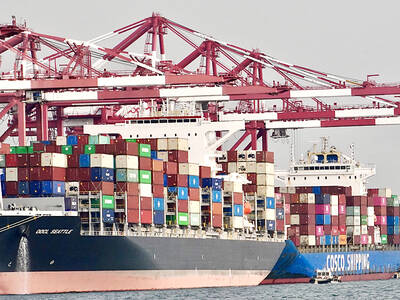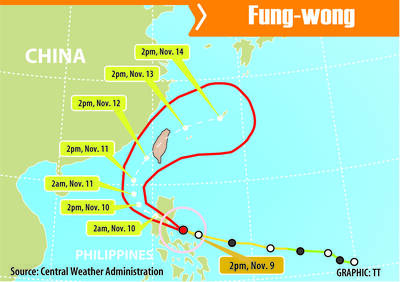Central China’s worst drought in more than 50 years is drying reservoirs and stalling rice planting, and threatens crippling power shortages as hydroelectric output slows, state media said yesterday.
Rainfall levels from January to last month in the drainage basin of the Yangtze, China’s longest and most economically important river, have been 40 percent lower than average levels of the past 50 years, the China Daily said.
The national flood and drought control authority has ordered the Three Gorges Dam, the world’s largest hydroelectric project, to increase its discharge of water by 10 percent to 20 percent for the next two weeks.
The measure is aimed at sending badly needed water to the Yangtze’s middle and lower reaches for drinking and irrigation.
Watermarks in more than 1,300 reservoirs in Hubei Province, where the dam is located, have dropped below allowable discharge levels for irrigation, the paper quoted Hubei Reservoir Management Director Yuan Junguang (袁俊光) as saying.
Rainfall in some areas is as much as 80 percent lower than usual, while the provinces of Anhui, Jiangsu, Hubei, Hunan, Jiangxi and Zhejiang along with Shanghai municipality are mired in their worst droughts since 1954.
“Without adequate water, we lost the spring planting season for rice,” Hubei farmer Zhou Xingtao was quoted as saying.
The paper said many other farmers in Hubei have lost their existing crops or given up on planting summer rice, fearing the emergency water supplies will be inadequate to sustain their fields, with more hot and dry weather forecast.
The agricultural impact is likely to further alarm officials already trying to tame high prices of key items such as food.
China — and the Yangtze river region in particular — is prone to the alternating threats of crippling drought followed by devastating flooding.
Just last summer, sustained torrential rainfall across the region caused widespread flooding and even some concern over whether the giant Three Gorges Dam would be able to contain the deluge.
More than 3,000 people were reported killed in the flooding and related landslides.
Nearly every year, some part of China suffers its worst drought in decades, and meteorological officials have said previously the extreme weather may be because of climate change.
The State Grid, China’s state-owned power distributor, reportedly said this week that 10 of its provincial-level power grids were suffering severe shortages because of the drought’s impact on hydroelectric generation, including grids in Shanghai and the heavily populated southwestern Chongqing region.
China could face a summer electricity shortage of 30 gigawatts — the most severe power shortfall since 2004, the company said.
The drought is also posing a threat to the Yangtze basin’s highly endangered population of freshwater dolphins, as water levels have plunged as much as 3m in key dolphin areas, raising the risk of stranding the animals.
There are an estimated 1,000 of the dolphins — fewer than the giant panda — and that number is falling because of pollution and other environmental woes.

The Central Weather Administration (CWA) yesterday said it expected to issue a sea warning for Typhoon Fung-Wong tomorrow, which it said would possibly make landfall near central Taiwan. As of 2am yesterday, Fung-Wong was about 1,760km southeast of Oluanpi (鵝鑾鼻), Taiwan’s southernmost point, moving west-northwest at 26kph. It is forecast to reach Luzon in the northern Philippines by tomorrow, the CWA said. After entering the South China Sea, Typhoon Fung-Wong is likely to turn northward toward Taiwan, CWA forecaster Chang Chun-yao (張峻堯) said, adding that it would likely make landfall near central Taiwan. The CWA expects to issue a land

Taiwan’s exports soared to an all-time high of US$61.8 billion last month, surging 49.7 percent from a year earlier, as the global frenzy for artificial intelligence (AI) applications and new consumer electronics powered shipments of high-tech goods, the Ministry of Finance said yesterday. It was the first time exports had exceeded the US$60 billion mark, fueled by the global boom in AI development that has significantly boosted Taiwanese companies across the international supply chain, Department of Statistics Director-General Beatrice Tsai (蔡美娜) told a media briefing. “There is a consensus among major AI players that the upcycle is still in its early stage,”

The Central Weather Administration (CWA) yesterday said it is expected to issue a sea warning for Typhoon Fung-wong this afternoon and a land warning tomorrow. As of 1pm, the storm was about 1,070km southeast of Oluanpi (鵝鑾鼻), Taiwan’s southernmost point, and was moving west-northwest at 28 to 32kph, according to CWA data. The storm had a radius of 250km, with maximum sustained winds of 173kph and gusts reaching 209kph, the CWA added. The storm is forecast to pass near Luzon in the Philippines before entering the South China Sea and potentially turning northward toward Taiwan, the CWA said. CWA forecaster Chang Chun-yao (張峻堯) said

PREPARATION: Ferry lines and flights were canceled ahead of only the second storm to hit the nation in November, while many areas canceled classes and work Authorities yesterday evacuated more than 3,000 people ahead of approaching Tropical Storm Fung-wong, which is expected to make landfall between Kaohsiung and Pingtung County this evening. Fung-wong was yesterday morning downgraded from a typhoon to a tropical storm as it approached the nation’s southwest coast, the Central Weather Administration (CWA) said, as it issued a land alert for the storm. The alert applies to residents in Tainan, Kaohsiung, Pingtung and Taitung counties, and the Hengchun Peninsula (恆春). As of press time last night, Taichung, Tainan, Kaohsiung, and Yilan, Miaoli, Changhua, Yunlin, Pingtung and Penghu counties, as well as Chiayi city and county had